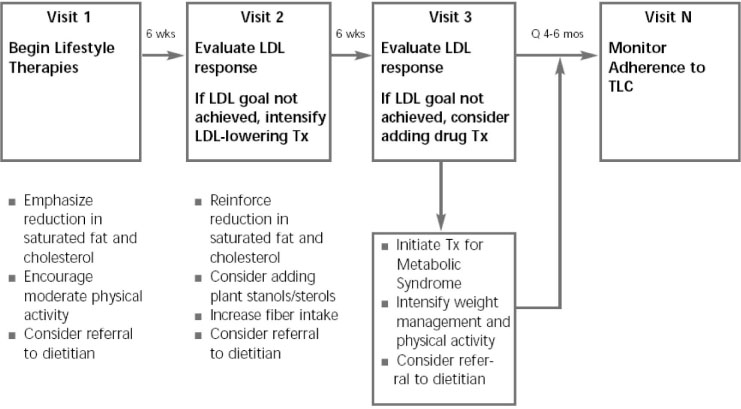J Korean Diabetes Assoc.
2007 Sep;31(5):377-382.
Non-drug Intervention in Lipid Management: Dietary Portfolio
- Affiliations
-
- 1Division of Endocrinology and Metabolism, Department of Internal Medicine, Pusan National University, College of Medicine.
Abstract
- Non-Pharmaceutical interventions are essential in lipid management. The NCEP recommends the following three tiered approach to lipid management: 1. Institution of therapeutic lifestyle changes (TLC); 2. Use of non-drug adjuncts, including viscous fibers and plant sterol/stanol products; and 3. Drug therapy when required to reach treatment goals. Even though non-drug approaches often receive minimal attention in clinical practice, the efficacy of non-drug therapies is not so small. Non-drug adjuncts are known to reduce LDL cholesterol as follows: 12.5% for 45 g of soy protein/d; 6% to 7% for 9 to 10 g of psyllium/d, with smaller reductions for other viscous fibers; 10% for 1 to 2 g of plant sterols/d and 1% for 10 g almonds/d. Recently, combining these foods in a single dietary portfolio decreased LDL cholesterol and CRP similarly to the extent which achieved by a usual dose of a statin. This dietary portfolio can be regarded as an effective non-drug approach to reduce the risk of cardiovascular disease.
MeSH Terms
Figure
Reference
-
1. Maki KC, Galant R, Davidson MH. Non-high-density lipoprotein cholesterol: the forgotten therapeutic target. Am J Cardiol. 2005. 96:59K–64K.2. Nissen SE, Nicholls SJ, Sipahi I, Libby P, Raichlen JS, Ballantyne CM, Davignon J, Erbel R, Fruchart JC, Tardif JC, Schoenhagen P, Crowe T, Cain V, Wolski K, Goormastic M, Tuzcu EM. ASTEROID Investigators. Effect of very high-intensity statin therapy on regression of coronary atherosclerosis: the ASTEROID trial. JAMA. 2006. 295(13):1556–1565.3. Grundy SM, Cleeman JI, Merz CNB, Brewer HBJ, Clark LT, Hunninghake DB, Pasternak RC, Smith SCJ, Stone NJ. Implications of recent clinical trials for the National Cholesterol Education Program Adult Treatment Panel III Guidelines. Circulation. 2004. 110:227–239.4. Davidson MH, Maki KC, Pearson TA, Pasternak RC, Deedwania PC, McKenney JM, Fonarow GC, Maron DJ, Ansell BJ, Clark LT, Ballantyne CM. Results of the National Cholesterol Education (NCEP) Program Evaluation ProjecT Utilizing Novel E-Technology (NEPTUNE) II survey and implications for treatment under the recent NCEP Writing Group recommendations. Am J Cardiol. 2005. 96:556–563.5. NIH National Heart, Lung, Blood Institute National Cholesterol Education Program. NIH Publication No. 01-3670. Detection, evaluation, and treatment of high blood cholesterol in adults (Adult Treatment Panel III) Executive Summary. 2001.6. Petchetti L, Frishman WH, Petrillo R, Raju K. Nutriceuticals in cardiovascular disease Psyllium. Cardiology in Review. 2007. 15:116–122.7. Katan MB, Grundy SM, Jones P, Law M, Miettinen T, Paoletti R. Stresa Workshop Participant. Efficacy and safety of plant stanols and sterols in the management of blood cholesterol levels. Mayo Clin Proc. 2003. 78:965–978.8. Moreyra AE, Wilson AC, Koraym A. Effect of combining psyllium fiber with simvastatin in lowering cholesterol. Arch Intern Med. 2005. 165:1161–1166.9. Maki K. Maximizing the role of non-drug interventions in lipid management: a call to action. Nutrition & the M.D. 2006. 32:1–4.10. Krauss RM, Eckel RH, Howard B, Appel LJ, Daniels SR, Deckelbaum RJ, Erdman JW Jr, Kris-Etherton P, Goldberg IJ, Kotchen TA, Lichtenstein AH, Mitch WE, Mullis R, Robinson K, Wylie-Rosett J, St Jeor S, Suttie J, Tribble DL, Bazzarre TL. AHA Dietary Guidelines: revision 2000: A statement for healthcare professionals from theNutrition Committee of the American Heart Association. Circulation. 2000. 102(18):2284–2299.11. Sacks FM, Lichtenstein A, Van Horn L, Harris W, Kris-Etherton P, Winston M. American Heart Association Nutrition Committee. Soy protein, isoflavones, and cardiovascular health: an American Heart Association Science Advisory for professionals from the Nutrition Committee. Circulation. 2006. 113:1034–1044.12. Sabaté J, Haddad E, Tanzman JS, Jambazian P, Rajaram S. Serum lipid response to the graduated enrichment of a Step I diet with almonds: a randomized feeding trial. Am J Clin Nutr. 2003. 77(6):1379–1384.13. Jenkins DJ, Kendall CW, Marchie A, Faulkner D, Vidgen E, Lapsley KG, Trautwein EA, Parker TL, Josse RG, Leiter LA, Connelly PW. The effect of combining plant sterols, soy protein, viscous fibers, and almonds in treating hypercholesterolemia. Metabolism. 2003. 52(11):1478–1483.14. Jenkins DJ, Kendall CW, Marchie A, Faulkner DA, Wong JM, de Souza R, Emam A, Parker TL, Vidgen E, Lapsley KG, Trautwein EA, Josse RG, Leiter LA, Connelly PW. Effects of a dietary portfolio of cholesterol-lowering foods vs lovastatin on serum lipids and C-reactive protein. JAMA. 2003. 290(4):502–510.15. Jenkins DJ, Kendall CW, Faulkner DA, Nguyen T, Kemp T, Marchie A, Wong JM, de Souza R, Emam A, Vidgen E, Trautwein EA, Lapsley KG, Holmes C, Josse RG, Leiter LA, Connelly PW, Singer W. Assessment of the longer-term effects of a dietary portfolio of cholesterol-lowering foods in hyperchole-sterolemia. Am J Clin Nutr. 2006. 83(3):582–591.
- Full Text Links
- Actions
-
Cited
- CITED
-
- Close
- Share
- Similar articles
-
- Lipid A as a Drug Target and Therapeutic Molecule
- Design and Implementation of a Web-based Portfolio Assessment System for a Family Medicine Residency Program in Korea
- Effects of Learning Activities on Application of Learning Portfolio in Nursing Management Course
- Development of a portfolio for competency-based assessment in a clinical clerkship curriculum
- Evaluation of a portfolio-based course on self-development for pre-medical students in Korea



